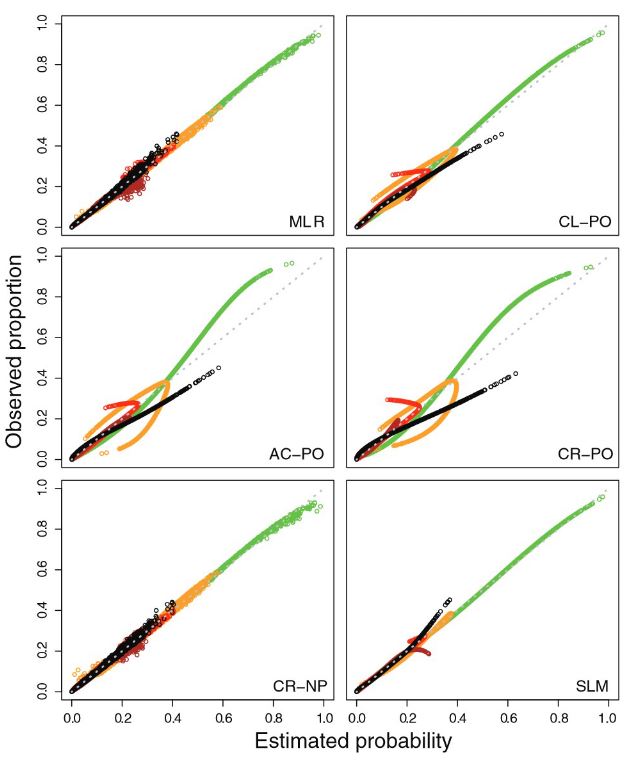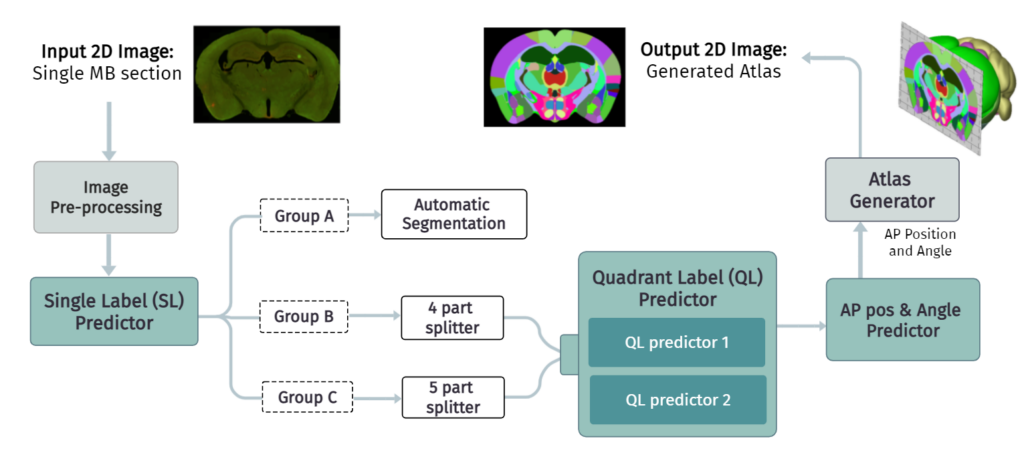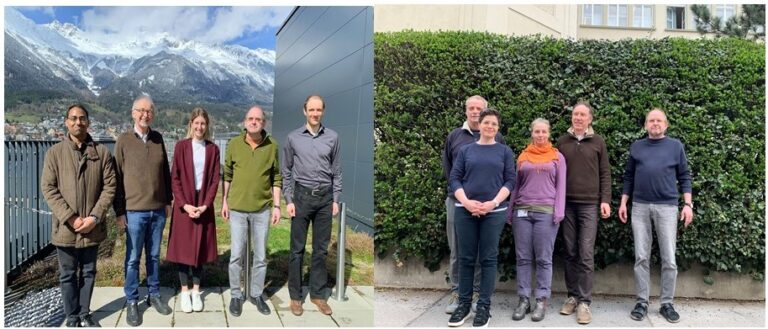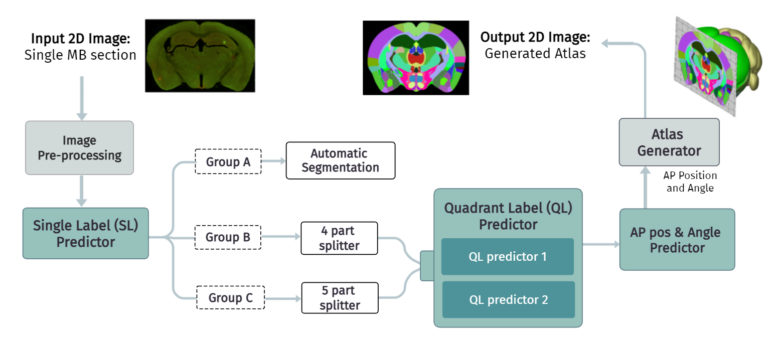
Schöpfstraße 41/1
6020 Innsbruck
Austria
Email: hanno.ulmer@i-med.ac.at
Website: http://www.i-med.ac.at/msig
Research year
Research Branch (ÖSTAT Classification)
305907, 305905, 305904, 303026, 303025
Keywords
Biobanking, Causal Inference, Clinical Trials, Epidemiology, Medical Informatics, Medical Statistics, Registries, Risk Prediction, and Sars-Cov-2
Research Focus
In Medical Statistics, we focus on developing risk prediction models in the framework of causal inference techniques with application in cardiovascular and cancer epidemiology.
In Informatics, working on a state-of-the-art biobanking infrastructure, we focus on integrating archived bio-specimens with clinical and molecular data whilst ensuring security and compliance. We further investigate deep learning modelling strategies in medical imaging based on histological tissue slices.
General Facts
The Institute of Medical Statistics and Informatics, formerly known as the Institute of Biostatistics and Documentation, was founded in 1969.
The Institute of Medical Statistics and Informatics provides a major contribution to the teaching of medical students. As well as offering compulsory lectures in semesters 1, 5 and 8, we focus on teaching diploma and PhD students. Students who are working on their diploma and PhD theses are advised on the use of appropriate statistical and epidemiological methods. Our weekly first aid lectures are highly appreciated by students looking for assistance with regard to research methodology. Recently, we designed a new module “Biostatistics” for the new joint LFU-MUI master program “Pharmaceutical Sciences – Drug Development and Regulatory Affairs“.
In addition, we provide statistical consultations to all researchers at MUI with a focus on clinical studies. Statistical consultation and collaboration are fundamental to the strong publication record of the institute. In relation to the number of employees, the institute has managed to hold top ranking within MUI in recent years with respect to the total number of publications: between 2020 and February 2023, a total of 151 original research papers were published by researchers from the institute as first, senior or co-author.
Research
Epidemiology of infectious disease: Sars-Cov-2
Hanno Ulmer, Katie Bates, Sarah Maier, Lalit Kaltenbach
In the reporting years 2020 and 2021 the international research community turned its interest towards Sars-Cov-2, as we did. In close collaboration with the Institute of Virology, we were working on two cross-sectional surveys taking place in the Austrian ski resort Ischgl, one of the early hotspots of the coronavirus. Later, we were involved in the planning and analysis of both the randomised HEVACC and SHIELDVACC vaccine trial. In cooperation with the teaching hospital LKH Feldkirch, we were among the first who evaluated the new Sars-Cov-2 vaccine in vulnerable patient groups such as dialysis and cancer patients. Initiated by Raimund Helbok from the Department of Neurology, Lalit Kaltenbach established a worldwide database (later named EAN NEuro-covid ReGistrY, ENERGY) that provides epidemiological data on neurological manifestations in patients with Sars-Cov-2 infection reported by neurologists.
Clinical Trials and Registries
Hanno Ulmer, Sarah Maier, Lalit Kaltenbach
Multicentre trials with major participation from our institute include the EU-funded Gannet53 and EUDARIO randomised control trials as well as other studies, such as the CAST-HF, HFIRON, TAVR-CMR, COME TOGETHER, MSA-PAIN, MiFlaPRO, INN-WOP1, MBC-6, HEVACC, NCT-CoV and ENZIAN. Marina Riedmann and Sarah Maier provide high-quality statistical consulting to clinical researchers and actively participate in study planning and data analysis.
As the responsible IT manager, Lalit Kaltenbach has developed an e-CRF system for both multicentre trials as well as disease related registries. The institute currently runs four Austrian-wide registries: the PCI registry, the IIK registry, the Ablation registry and the Parkinson’s registry.
We support clinical researchers in all aspects of statistical study planning, protocol writing, applications for ethical review, data management, statistical analyses and publication. We provide expertise on the use of statistical (R, SAS, Stata, SPSS etc.) and data management software (REDCap).
To support researchers with submitting PhD and habilitation theses, Joachim Masser developed the PubMon programme. This facilitates the administration of the personal publication record of MUI researchers, including impact factors, citations and journal rankings.
Cancer Epidemiology
Hanno Ulmer, Josef Fritz
In cancer epidemiology, we investigate metabolic and lifestyle factors as potential risk factors for cancer incidence and mortality. Metabolic syndrome is a cluster of factors characterised by obesity, hypertension, dyslipidaemia and high blood glucose. The prevalence of metabolic syndrome is rising worldwide. Individuals with metabolic syndrome have a higher risk of cardiovascular disease and diabetes, but little is known about the links with cancer.
We are participating in the Me-Can project, which holds a large database of health examination data of about 570,000 individuals from Sweden, Norway and Austria. Measurements such as height, weight, blood pressure, blood glucose, triglycerides and total cholesterol were recorded between 1972 and 2004. Individuals in the database have been followed until their death, emigration or the end of follow-up, according to the principles of epidemiological cohort studies. To obtain cause-of-death and cancer incidence information, the database has been linked to cancer registries in each country. The institute is a key player in the Me-Can project.
One recent study of the Me-Can project highlights that the type of metabolic phenotype is important when assessing obesity related cancer risk. Metabolic aberrations further increased the obesity-induced cancer risk, suggesting that both obesity and metabolic aberrations are useful targets for prevention.
Cardiovascular Epidemiology
Hanno Ulmer, Josef Fritz
Using data from the population-based Vorarlberg health examination database (VHM&PP), we have been investigating the role of metabolic risk factors such as obesity, blood pressure, blood lipids, blood sugar, gamma-glutamyl transferase and uric acid in cardiovascular disease since 2003. The latest publications in a long tradition focused on risk factors for end stage kidney disease (ESKD). This endpoint for our cohort was added by matching the participant data with the Austrian Dialysis and Transplant Registry. In a first study, we investigated whether the triglyceride-glucose (TyG) index as a measure of insulin resistance is associated with the risk of developing ESKD. We found that the TyG index seemed to be strongly associated with ESKD risk and mediated almost half of the total association between BMI and ESKD in Austrian adults.
Josef Fritz and Hanno Ulmer worked on statistical methods that allow multiple mediators in complex situations and they are applying these methods to a study, with the aim of better understanding of the underlying mechanism of the effect of obesity on the risk of end-stage chronic kidney disease. This study found that TyG index, mean arterial pressure and uric acid, but not total cholesterol, mediated the association of BMI with ESKD in middle-aged adults. Our findings highlight that, in addition to weight reduction, the control of metabolic risk factors are essential in mitigating the adverse effects of BMI on kidney function. For this work, Josef Fritz was awarded with the “Förderpreis der Österreichischen Gesellschaft für Nephrologie 2022”. (figure 2)
![Fig. 2: Underlying causal framework of the relationship between BMI and ESKD. Directed acyclic graph depicting the conceptional framework between exposure overweight/obesity (E; operationalized as BMI); mediators insulin resistance (M1), hypertension (M2), hyperuricemia (M3), and hypercholesterolemia (M4) (operationalized as TyG index, MAP, UA, and TC, respectively); outcome ESKD (O); and relevant confounders age, sex, and smoking status. Dotted arrows represent confounding pathways, whereas the other arrows (solid [indirect effects via mediators] and dashed [direct effect of overweight/obesity]), due to their unidirectionality, can convey exposure effects to the outcome, and are thus causal pathways (Copyright: Journal of the American Society of Nephrology 33(7):1377-1389, July 2022.)](https://researchreport.i-med.ac.at/wp-content/uploads/2023/07/medical_statistics_fig2-1024x576.jpg)
Statistical and Epidemiological Methods
Hanno Ulmer, Michael Edlinger, Josef Fritz
The institute has a strong research record in the field of causal inference, developing and applying mediation analysis techniques to epidemiological research problems. Taking into account potential outcomes, so called counterfactuals, these techniques aim to detect the underlying mechanisms and to clarify why and how exposure produces the outcome of interest.
Michael Edlinger places his research focus on the validation of prediction models. Edlinger et al. published a paper about risk prediction models for discrete ordinal outcomes, where they assessed the calibration and the impact of the proportional odds assumption. They concluded that non-proportional odds models require more parameters to be estimated from the data, and hence suffer more from overfitting. Despite larger sample size requirements, the authors generally recommend multinomial logistic regression for risk prediction modelling of discrete ordinal outcomes. Figure 3

Biobanking and BioMolecular Resources Research Infrastructure (www.BBMRI.at)
Georg Göbel, Michael Henrich, Helga Hauffe, Ramona Folie, Joachim Masser, Martina Kinzl
BBMRI.at aims to develop a cutting-edge biobanking infrastructure for Austria in order to increase cooperation and harmonisation among biobanks and towards industry. Since 2014, the local research team at the Institute has worked on establishing common guidelines for the collection of human bio-samples and on data management, in order to implement a university-wide, state-of-the-art biobanking infrastructure at the Medical University of Innsbruck (MUI).
At present, several independent, decentralised collections of human biomaterials are located in various institutions of the MUI. Based on the approval of the local ethics committee, most of these separate sample collections are linked to pseudonymised, detailed clinical data. The project aims to integrate archived bio-specimens with clinical and molecular data in a collaborative environment that emphasises scientific insights whilst ensuring security and compliance. An upcoming issue will be the digitalisation of FFPE slides. In addition, a comprehensive biobank management system will be launched in order to support researchers with collection, sample and quality management tasks. The software will enable users to integrate patient materials, clinical, specimen, genetic and molecular assay data, in order to deliver a holistic, unified view; it facilitates data exploration and hypothesis-driven research without extra programming or IT support. Multi-level user access controls ensure that all collaborators can work effectively, whilst ensuring compliance with patient consent and maintaining regulatory guidelines.
As the second part of this project, the team in Innsbruck is working on a reference model for sample and data collections as cutting edge light-house (LHC) for other sample collectors and users. In this context, a LHC criteria catalogue and an assessment process is being established in cooperation with the other Medical Universities in Austria (Graz, Linz, Wien).
Common Service IT – BBMRI
Georg Göbel, Ramona Folie, Maryam Sadeghi, Joachim Masser, Martina Kinzl
Within the BBMRI Common Service IT, several tools are currently developed to ensure the findability of international biobanking and biomolecular resources (BBMRI Directory, BBMRI Negotiator) in order to facilitate access to biobanks for potential researchers and industrial users. Our team is responsible for a systematic and interactive feedback process of the user interfaces and functionalities based on human-centred usability engineering approaches. Issues to be addressed include user’s learnability and memorability. The identified design issues derive recommendations for designers and developers to improve future designs of the BBMRI Tools, but also for developers of similar online biobank catalogues.
Medical Informatics, Artificial Intelligence and Deep Learning
Maryam Sadeghi, Hanieh Hashemian, Georg Göbel
In the context of experimental brain images, mapping of histological images to a reference atlas is still challenging in terms of accuracy, universality and time efficiency. The first issue is that brain histological datasets often suffer from artefacts such as missing tissue, folding, air bubbles, uneven staining or tears or due to the deformations introduced during slice preparation procedures. The second problem arises from non-standard angles of sliced brain sections which cannot be attributed to a single reference atlas slice.
Maryam Sadeghi is currently investigating deep learning methods to localise 2D histological mouse brain slices in the standard 3D reference mouse brain atlas and registers them consecutively. Her software provides a deep learning-based mapping pipeline, which has been evaluated by means of a validation measure in comparison with basic truth data. It has also been proven usable in other context such as rat brain. The software is currently being used in two research groups in the Netherlands Institute of Neuroscience, Amsterdam. Figure 4

Pictures
Selected Publications
Fritz J, Brozek W, Concin H, Nagel G, Kerschbaum J, Lhotta K, Ulmer H, Zitt E. The Triglyceride-Glucose Index and Obesity-Related Risk of End-Stage Kidney Disease in Austrian Adults. JAMA Netw Open. 2021 Mar 1;4(3):e212612. doi: 10.1001/jamanetworkopen.2021.2612. PMID: 33787913; PMCID: PMC8013829.
Fritz J, Brozek W, Concin H, Nagel G, Kerschbaum J, Lhotta K, Ulmer H, Zitt E. The Association of Excess Body Weight with Risk of ESKD Is Mediated Through Insulin Resistance, Hypertension, and Hyperuricemia. J Am Soc Nephrol. 2022 Jul;33(7):1377-1389. doi: 10.1681/ASN.2021091263. Epub 2022 May 2. PMID: 35500938; PMCID: PMC9257805.
Edlinger M, van Smeden M, Alber HF, Wanitschek M, Van Calster B. Risk prediction models for discrete ordinal outcomes: Calibration and the impact of the proportional odds assumption. Stat Med. 2022 Apr 15;41(8):1334-1360. doi: 10.1002/sim.9281. Epub 2021 Dec 12. PMID: 34897756; PMCID: PMC9299669.
Sun M, Fritz J, Häggström C, Bjørge T, Nagel G, Manjer J, Engeland A, Zitt E, van Guelpen B, Stattin P, Ulmer H, Stocks T. Metabolically (un)healthy obesity and risk of obesity-related cancers: a pooled study. J Natl Cancer Inst. 2023 Jan 17:djad008. doi: 10.1093/jnci/djad008. Epub ahead of print. PMID: 36647199.
Maryam Sadeghi, Pedro Neto, Arnau Ramos-Prats, Federico Castaldi, Enrica Paradiso, Naghmeh Mahmoodian, Francesco Ferraguti, Georg Goebel, “Automatic 2D to 3D localization of histological mouse brain sections in the reference atlas using deep learning,” Proc. SPIE 12032, Medical Imaging 2022: Image Processing, 120322P (4 April 2022); https://doi.org/10.1117/12.2604231
Selection of Funding
Lise Meitner scholarship (Katie Bates) The Ischgl Follow-up study (FUPS Ischgl), FWF M3069-B
Collaborations
Ben Van Calster, KU Leuven, Belgium
Hans Concin, Arbeitskreis für Vorsorge- und Sozialmedizin, Bregenz, Austria
Majid Ezzati, Imperial College London, UK
Cecily Kelleher, University College Dublin, Ireland
Gabriele Nagel, University of Ulm, Ulm, Germany
Ruth Pfeiffer, National Cancer Institute, Bethesda MD, USA
Kaspar Rufibach, Roche Basel, Switzerland
Eva Schernhammer, Medizinische Universität Wien, Austria
Tanja Stocks, Lund University, Malmo, Sweden Text
Emanuel Zitt, Landeskrankenhaus Feldkirch, Austria

![Fig. 2: Underlying causal framework of the relationship between BMI and ESKD. Directed acyclic graph depicting the conceptional framework between exposure overweight/obesity (E; operationalized as BMI); mediators insulin resistance (M1), hypertension (M2), hyperuricemia (M3), and hypercholesterolemia (M4) (operationalized as TyG index, MAP, UA, and TC, respectively); outcome ESKD (O); and relevant confounders age, sex, and smoking status. Dotted arrows represent confounding pathways, whereas the other arrows (solid [indirect effects via mediators] and dashed [direct effect of overweight/obesity]), due to their unidirectionality, can convey exposure effects to the outcome, and are thus causal pathways (Copyright: Journal of the American Society of Nephrology 33(7):1377-1389, July 2022.)](https://researchreport.i-med.ac.at/wp-content/uploads/2023/07/medical_statistics_fig2-768x432.jpg)
